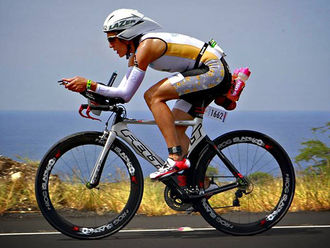Katherine West - Portfolio
Journeys in Sustainable Fashion & Contour Fashion:
Research, Design, Making, Retail & Display




Bespoke Triathlon Apparel
As part of the Verus Activewear Collection and Research project I also trialled the 'Bespoke Triathlon Apparel' service concept, under 'Made By Katherine West'. With the aim of co-designed, bespoke personalised designs (with the athlete/garment user) being able to build enhanced emotional durability into the garment and therefore longevity.
In this case I co-designed & developed and constructed a bespoke, personalised Long Course Triathlon Suit (with a crop top style Sports Bra), for 'Age-Group' Triathlete, Claire Shea-Simonds. It was specifically designed for her to compete at the Ironman World Championships in Kona (Big Island, Hawaii), in October.
Based on the Verus Activewear Long Course Triathlon Suit (Outfit 4) and then adapted and developed to give a perfect fit on the athletes body (to be hydro and aerodynamic) and to include additional design features to allow the best performance possible during the race (distance and climate/weather conditions). Claire was also able to co-design a pattern design which aimed to inspire her through training and on race day. The pattern design and the colours of the suit were determined by her Triathlon club colours of black, white and orange.
Along with the performance design features already incorporated in to the garments of the 'Verus Activewear Collection', several specific design features were added to aid Claire during this race. The Ironman Triathlon distance includes a swim stage of 2.4 miles (in the ocean), cycle stage of 112 miles and a run stage of 26.2 miles (a marathon). The following gives an idea of the terrain, wind speed and temperature conditions expected:
Water temperature: approx. 79 degrees Fahrenheit.
-
Wind temperature: 80-90 degrees Fahrenheit.
-
During certain sections of the course, temperatures can exceed 100 degrees Fahrenheit due to heat being reflected from both lava and asphalt.
-
Wind speed: ranging between 5mph and 60mph.
-
Cycle course: ranges between 75-300ft and rises to 600-650ft in parts.
-
Run course: ranges between 10ft and 161ft.
(2013, www.ironman.com)
The Long Course Triathlon suit for Claire, was also designed to include:
-
Fabric composition and cut of the design (of the lower body) provides compression and stabilisation to the leg muscles helping to reduce fatigue.
-
The use of fabrics that gave protection from strong UV rays. For the suit and the sports bra.
-
The white fabric of the body has a very soft finish for comfort against the skin during the long duration of activity and to aid in the reflection of heat.
-
A crop top style sports bra, cut in a firm but lightweight and breathable fabric, to provide the right level of support to the bust during the running stage and to feel comfortable during the swim and cycle.
-
A specially selected thin cycling insert to aid comfort during the long cycle phase of the race, but to not feel bulky and uncomfortable during the long swim and run phases.
-
The white fabric also acting as a good background to the sponsor logos, making them stand out and be visible.
The outfit was trialled at a Triathlon race (an Olympic distance) in the UK, 2 months prior to the Ironman race. Following this, the neck edge was re-shaped a little to better contour the athlete's body and was changed from white to black, as suncream was found to be discolouring the trim. We then also found in the race rules that Claire would need to have GBR on the front of the suit (as well as on the back). We had hoped to avoid this in the design, as with this being a Long Course Triathlon Suit it has a zip at the front, so that it can be lowered during the run stage to aid in heat and moisture leaving the body. This meant that GBR had to be added, with half of the print on either side of the zip. This doesn't work very well aesthetically, but was unavoidable if she wanted to compete in the race.
With the long distance of the swim stage of the Ironman Championship race, Claire experienced a 'normal' amount of rubbing of the arm hole trims and side seams against the skin. The swimming action causes the fabric soaked in salt water to move against the skin. To Claire it feels as if the salt water is more abrasive than river/lake or chlorinated water. In the future I would like to be able to remove this issue altogether from the design and be able to use elastomeric fabrics that can have a raw edge and do not need a finished edge. I would also like to explore welded seams over sewn seams, although I'm unsure of the potential ecological impact of the current substance that is heated to bind the two surfaces. I would like to explore whether there is another alternative substance, something either in 'natural' nature or synthetic biology.








